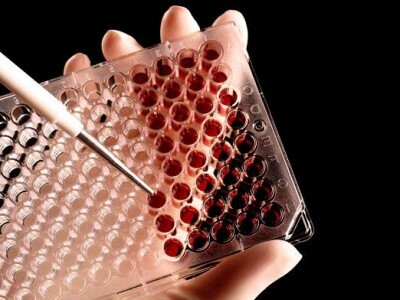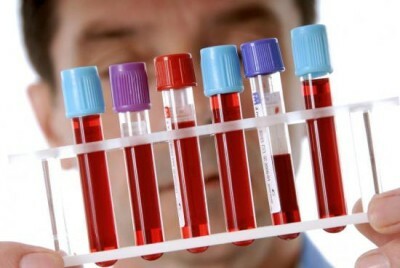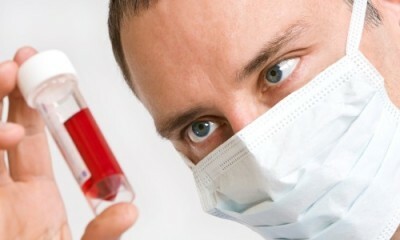1 Blood donation rules for biochemistry
- blood is given in the morning on an empty stomach;
- the procedure is carried out only under sterile conditions with the use of disposable devices;
- a week before the day of the study does not use salty, hot and fatty foods, foods, alcohol;
- for 2 hours before the procedure can not be smoked;
- 72 hours before blood donation, you can not visit saunas, baths, solariums;
- first make a biochemical blood test, then there are other prescribed tests - urine delivery, ultrasound, MRI;The
- person should be calm during the procedure;
- to determine the exact sugar value, do not drink sweet tea before the procedure;
- should not use medicines containing hormones, antibacterial agents, diuretics, blood thinning medications;
- the doctor receives the results;
- in case the rules were violated, the biochemical blood test can be retaken in a week.

Recommended to read
- Bilirubin norm
- What is the method for gastric diagnostics of esophagogastroduodenoscopy?
- Detailed review of the method for diagnosis of intestinal irrigation
- Effective agent for gastritis and gastric ulcer
The time of these studies - 5 minutes, the doctor will be able to decipher the analysis in 24 hours.
2 Protein level
Protein is the building material of the body. It is a part of absolutely all tissues - skeletal musculature, cell membranes. Participates in the transfer of substances, metabolic processes, accelerates biochemical reactions, determines the foreign elements that enter the body.
Elevated levels of protein molecules indicate dehydration, gastrointestinal diseases, large blood loss, malignant neoplasms, chronic and acute inflammatory process, which can occur secretly.
-
 IMPORTANT TO KNOW! Gastritis? Ulcer? To have a stomach ulcer not turned into cancer, drink a glass. ..Read the article & gt; & gt;
IMPORTANT TO KNOW! Gastritis? Ulcer? To have a stomach ulcer not turned into cancer, drink a glass. ..Read the article & gt; & gt;

In the blood, the norm of the content of protein molecules for newborns is 72, up to 12 months - 71, from 1 to 6 years - 74, to 7 years - 77, to 17 years - 75, in adults the indicator for biochemical blood analysis should not exceed82.
The content of low-molecular nitrogen compounds.
If, when examining the form, an increased blood urea ratio is recorded, this is due to a malfunctioning of the renal system, a high level of protein molecules, and the possible development of acute cardiac disorders. Underestimated indices, protein starvation develops, suction processes are disrupted. The normal indicator of biochemical analysis of this element in children is 9.84;in an adult - 10.67.
An overestimate uric acid level can detect gout, kidney failure. The level decreases if there are diseases of the central nervous system, impaired renal tubular function. The established norm: children - 321, adult women - 351, adult men - up to 421.
4 Indicators of fats, water and salt
If the metabolic processes of fats are violated in the human body, the level of lipids in the blood immediately increases. In general, such indicators are characteristic of people with excess weight, in the presence of hepatitis, atherosclerosis, nephrosis, diabetes.
Normal values of total cholesterol - 6.24;LDL( men) -4.83, LDL( women) - 4.50;HDL( men) - 4.74, LDL( women) -3.29.
The increased fat ratio indicates that a person has hepatic pathologies, there is a genetic predisposition to hyperlipoproteinemia, mental abnormalities, stroke. Increases the level of fats when bearing a child and when taking contraceptive medications.
WE RECOMMEND!
For prevention and treatment of Digestive Diseases our readers advise Monastic tea. This unique remedy consists of 9 medicinal herbs useful for digestion, which not only complement, but also enhance each other's actions. Monastic tea will not only eliminate all symptoms of the gastrointestinal tract and digestive system, but will also permanently eliminate the cause of its occurrence.
Opinion of doctors. .. "
The level of fats decreases with an overabundance of hormone production by the thyroid gland, violation of digestibility of enzymes.
HDL cholesterol rises in diseases of the liver, cardiovascular system, nervous diseases. LDL - with hereditary genetic diseases.
Triglycerides are derivatives of cholesterol. Their number increases with alcoholism, ischemia, various types of hepatitis, sarcoma. A reduced indicator is a signal about disturbed absorption processes.

Normal triglyceride values vary with age. For young people under 21, they should not exceed 4.8, for girls - 3.8.In men under 50 years of age - 6.4, in women - 3.6, in the elderly, respectively - 6.7 / 6.0.
To inorganic compounds, the level of which is determined in the biochemical analysis of blood, include Fe, K, Mg, F, Cl, Ca, Na, vitamins.
By conducting a thorough investigation of blood elements, it is possible to identify the relationship between metabolic processes of water and salts.
Disorders of the metabolic processes can occur due to poisoning, intoxication of the body, violations of the heart muscle, after the nervous breakdown and neuroses.
When examining blood for biochemistry, special attention is paid to the coefficients K, Na, Cl, which are entered in the form. They play an important role in many metabolic processes. Deviation from the norm in the direction of "plus" indicates damage to erythrocytes, violation of water balance in cells, acute renal failure. Lowering the level of these elements indicates chronic hunger( non-occurrence of K with food), functional disorders of the renal system, water-salt metabolic processes, poisoning with salicylates.
Normally, the main potassium indices should be as follows: in children -1, 7;13 - 60 years - no more than 6,1.Sodium - up to 144, chlorine - up to 106.
Ca is no less important element in the body. Without it, nerve impulses are not carried out in the heart muscle, muscle contractions, coagulability of the blood are not possible.
If the level of this element increases with a biochemical examination of the blood, then this can be a sign of development and division of malignant cells, excess vitamin D, dehydration, diseases of the nervous system, mental abnormalities. The indicator decreases for violations of the thyroid gland, chronic renal failure, hypoalbuminemia. Normally the coefficient of this element should not exceed 2.51.
Phosphorus is a component that is part of the nucleic acid, bones. Responsible for cellular energy supply.
If the body is destroyed by bone tissue in leukemia, sarcoidosis, there is an excess of vitamins, parathyroid gland function is reduced, then the phosphorus indicator in biochemical blood analysis will be overestimated. Coefficient below the norm indicates a lack of growth hormone, the development of rickets. Normal index: in children - up to 1,17, in adolescents - 2,79, for 75 years - 2,31, for people over 80 years - 1,15.
Magnesium is a potassium antagonist. Thanks to this element, the muscles have a property to relax. Takes part in protein metabolism.
An increase in this element is a sign of dehydration, renal and adrenal insufficiency, multiple myeloma. The indicator below the norm indicates that there was a conception, a chronic form of alcoholism, acute pancreatitis. Normally magnesium should not exceed 1.06.
Iron is a necessary element for an organism. With its overabundance, hemolytic anemia, acute leukemia develops. The indicator decreases on the background of hypothyroidism, malignant neoplasms, diseases of the gastrointestinal tract, brain. The norm is not more than 30.42.
Vitamin B, folic acid provide cell division, regeneration. An increase in the level of these elements can be the result of malnutrition, impaired absorption processes, alcoholism. Norm - 18.
Vitamin B12 is needed for the normal functioning of the spleen and renal system. The lack of an element leads to serious pathological processes, for example anemia. Its content should not exceed in the blood 899 pg / ml( normal).
3 Parameters of carbohydrates and pigments
The glucose value is 4.35-6.84.If a small increase in its level is recorded in the form, this indicates that the person is emotionally excited, stressed or feels pain. Increases the level of glucose, if the rules of the analysis were violated and the person ate breakfast in the morning.
-
 Gastroenterologist. VAZHENOV: "I beg you, if you began to worry about abdominal pain, heartburn, nausea, do not do gas in any way. .."Read more & gt; & gt;
Gastroenterologist. VAZHENOV: "I beg you, if you began to worry about abdominal pain, heartburn, nausea, do not do gas in any way. .."Read more & gt; & gt;
The glucose test reveals the presence of diabetes mellitus, brain diseases or a predisposition to them.

The level is lowered if a person is on a diet, there is an overdose of insulin, pancreatic disease, dysfunction in the thyroid gland, poisoning.
Another carbohydrate that is being tested during biochemistry is fructosamine. The normal coefficient is 206-286.Children score slightly less than in adulthood. Decoding of the biochemical analysis of blood in adults is carried out according to a separate table.
The increase in fructosamine can be caused by:
- kidney disease;
- elevated sugar level;
- with hypothyroidism.
The reduced coefficient, recorded in the form, indicates hypoalbuminemia( nephrotic syndrome), diabetic nephropathy.
The level of enzymes in the blood decreases if a person takes ascorbic acid.
With the help of bilirubin you can determine hepatitis and assess the severity and extent of the disease. A characteristic sign of pathological processes in the liver is the intensive growth of direct bilirubin. The mechanical jaundice helps to increase the enzyme in the blood tens of times. Hemolytic icicle increases indirect bilirubin. Normally its value is 6-21 mol / l. The coefficient 26 indicates that a person has become ill with hepatitis. The higher values of the biochemical blood test, which are recorded in the form, are noted in case of liver poisoning or sarcoma, in the presence of malignant cells, developing urolithiasis.
ADVICE FROM THE MAIN GASTROENTEROLOGIST
Korotov SV: "I can recommend only one remedy for the rapid treatment of Ulcer and Gastritis, which is now recommended by the Ministry of Health. .." Read the reviews & gt; & gt;
The norm of these elements is 3.56.Deviations from the standard indicate the onset of acute viral inflammation of the liver, infectious inflammatory processes, jaundice in the period of gestation or hypothyroidism in infants.
5 Enzymatic coefficients
The level of enzymes in the blood during biochemical analysis is determined to reveal pathologies in the endocrine system, the liver. If the liver is damaged, the ALT, AST coefficient will be too high. The increase in the number of amylase molecules indicates pancreatic diseases, creatinine - about kidney pathologies.
The ALT indices recorded in the results form indicate a necrosis in the tissues of the liver, heart muscle, jaundice, hepatitis. Normal indicators should not exceed 32 in women, 42 in men.
Another enzyme, which can indicate the presence of myocardial infarction, liver metastasis - ACAT.Its content in the analysis should not be more than 32 for women, 42 for men.
Biochemical blood test, decoding allows to identify early pathologies and apply appropriate treatment. To hand over analyzes it is desirable every 3 months. Biochemistry of blood is carried out in any medical institution.
- 1 Rules for donating blood for biochemistry
- 2 Protein level
- 3 Indicators of carbohydrates and pigments
- 4 Indicators of fats, water and salt
- 5 Enzymatic coefficients
Biochemical blood analysis is an extensive laboratory research technique that allows you to evaluate the performance of all systems and organs. About how to decipher the biochemical analysis knows any attending physician. It is used in absolutely all medical fields. The blood test for biochemistry is prescribed for any possible pathologies or suspicions for them. The main task of this study is the determination of pathologies in the body.
The decoding is performed by the attending physician, using a table of indicators that is compared with the data and entered on the form.
Do you have gastritis?
GALINA SAVINA: "How easy is it to cure gastritis at home for 1 month." "A proven method is to write down a recipe. ..!"Read more & gt; & gt;
You do not need to try to decipher the biochemical blood test yourself. This can only be done by a specialist. And in some cases deviations of indicators from the norm are provided, which are not pathologically dangerous for people. In the processing of data and the diagnosis is taken into account the genetic predisposition to diseases, the age of the patient, the history of diseases transferred earlier.



